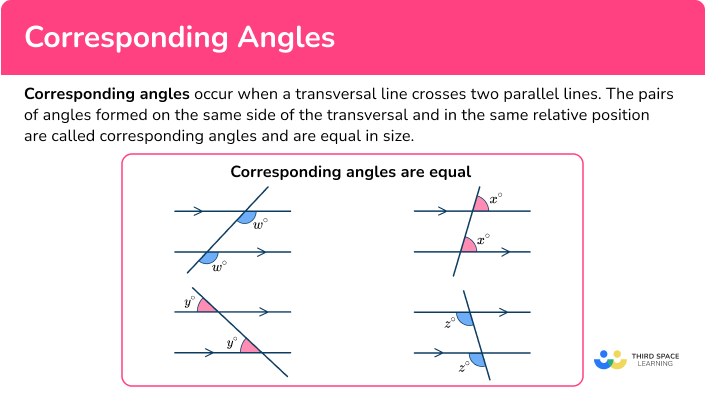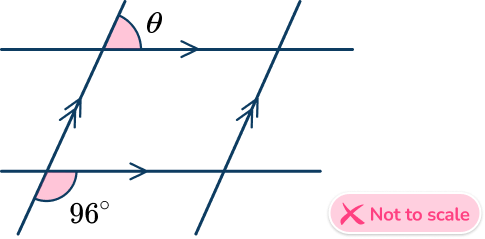High Impact Tutoring Built By Math Experts
Personalized standards-aligned one-on-one math tutoring for schools and districts
In order to access this I need to be confident with:
Angles Measuring angles Complementary angles Supplementary angles Straight angleCorresponding angles
Here you will learn about corresponding angles including how to recognize corresponding angles and apply this understanding to solve problems.
Students will first learn about corresponding angles as part of geometry in 8 th grade and expand their learning in high school.
Every week, we teach lessons on corresponding angles to students in schools and districts across the US as part of our online one-on-one math tutoring programs. On this page we’ve broken down everything we’ve learnt about teaching this topic effectively.
What are corresponding angles?
Corresponding angles occur when a transversal line crosses two parallel lines. The pairs of angles formed on the same side of the transversal and in the same relative position are called corresponding angles and are equal in size.

You can often spot corresponding angles by drawing an F shape.

What are corresponding angles?

Common Core State Standards
How does this relate to 8 th grade math and high school math?
- Grade 8 – Geometry (8.G.A.5)
Use informal arguments to establish facts about the angle sum and exterior angle of triangles, about the angles created when parallel lines are cut by a transversal, and the angle-angle criterion for similarity of triangles. For example, arrange three copies of the same triangle so that the sum of the three angles appears to form a line, and give an argument in terms of transversals why this is so.
- High School – Geometry (HSG.CO.C.9)
Prove theorems about lines and angles. Theorems include: vertical angles are congruent; when a transversal crosses parallel lines, alternate interior angles are congruent and corresponding angles are congruent; points on a perpendicular bisector of a line segment are exactly those equidistant from the segment’s endpoints.
![[FREE] Corresponding Angles Worksheet (Grade 8 And High School)](https://thirdspacelearning.com/wp-content/uploads/2024/11/Corresponding-Angles-Worksheet-listing-image.png)
[FREE] Corresponding Angles Worksheet (Grade 8 And High School)
![[FREE] Corresponding Angles Worksheet (Grade 8 And High School)](https://thirdspacelearning.com/wp-content/uploads/2024/11/Corresponding-Angles-Worksheet-listing-image.png)
Use this worksheet to check your 8th grade and high school students’ understanding of corresponding angles. 15 questions with answers to identify areas of strength and support!
DOWNLOAD FREE NOW![[FREE] Corresponding Angles Worksheet (Grade 8 And High School)](https://thirdspacelearning.com/wp-content/uploads/2024/11/Corresponding-Angles-Worksheet-listing-image.png)
[FREE] Corresponding Angles Worksheet (Grade 8 And High School)
![[FREE] Corresponding Angles Worksheet (Grade 8 And High School)](https://thirdspacelearning.com/wp-content/uploads/2024/11/Corresponding-Angles-Worksheet-listing-image.png)
Use this worksheet to check your 8th grade and high school students’ understanding of corresponding angles. 15 questions with answers to identify areas of strength and support!
DOWNLOAD FREE NOWHow to find corresponding angles
In order to find corresponding angles:
- Identify two parallel lines that are intersected by a transversal.
- Locate the angles that lie on the same side of the transversal and on different parallel lines.
- Recognize that these pairs of angles are corresponding angles and are congruent.
Corresponding angles examples
Example 1: find the corresponding angles
\overleftarrow{\,C}\overrightarrow{D\,} and \overleftarrow{\,E}\overrightarrow{H\,} are parallel lines.
Which angle is the corresponding angle to \angle ABC?

- Identify two parallel lines that are intersected by a transversal.
CD and EH are parallel lines. Line AG is the transversal.
2Locate the angles that lie on the same side of the transversal and on different parallel lines.

There are many pairs of corresponding lines, but the question asks which angle is a corresponding angle to \angle ABC. \angle BFE is on the same side of the transversal and on a different parallel line than \angle ABC.
3Recognize that these pairs of angles are corresponding angles and are congruent.
\angle BFE and \angle ABC are corresponding angles.
Example 2: find pairs of corresponding angles
\overleftarrow{\,S}\overrightarrow{Y\,} and \overleftarrow{\,T}\overrightarrow{Z\,} are parallel lines.
Name all pairs of corresponding angles.

Identify two parallel lines that are intersected by a transversal.
The two parallel lines are SY and TZ. Line UX is the transversal.
Locate the angles that lie on the same side of the transversal and on different parallel lines.
There are four pairs of angles that lie on the same side of the transversal and on different parallel lines. All 4 are pairs of corresponding angles.

Recognize that these pairs of angles are corresponding angles and are congruent.
The pairs of corresponding angles are:
\angle SVW and \angle TWX
\angle SVU and \angle TWV
\angle UVY and \angle VWZ
\angle YVW and \angle ZWX
Example 3: corresponding angles in a real-world object
Look at the road intersections shown below. Which two letters represent corresponding angles?

Identify two parallel lines that are intersected by a transversal.
The two horizontal roads are parallel lines, and the diagonal road is the transversal.
Locate the angles that lie on the same side of the transversal and on different parallel lines.
C and E are the only letters on the same side of the transversal and on different parallel lines.
Recognize that these pairs of angles are corresponding angles and are congruent.
C and E are corresponding angles.
How to find the missing angle with corresponding angles
In order to find the missing angle with corresponding angles:
- Highlight the angle(s) that you already know.
- Use corresponding angles to find a missing angle.
- Use basic angle facts if needed to calculate other missing angles.
Note: Steps 2 and 3 may be done in either order and may need to be repeated. Step 3 may not always be required.
Example 4: corresponding angles
Find the measure of the missing angle \theta. Justify your answer.

Highlight the angle(s) that you already know.

Use corresponding angles to find a missing angle.

Here you can label the corresponding angle on the diagram as 75^{\circ}.
Use basic angle facts if needed to calculate other missing angles.

Here \theta is on a straight line with 75^{\circ}
So,
\begin{aligned}\theta&=180^{\circ}-75^{\circ} \\\\ \theta&=105^{\circ}\end{aligned}
Example 5: corresponding angles
Find the measure of the missing angle \theta. Justify your answer.

Highlight the angle(s) that you already know.

Use corresponding angles to find a missing angle.
The new angles of 63^{\circ} and 56^{\circ} are corresponding angles to the original angles as shown above as they are on the same side of each transversal.
Use basic angle facts if needed to calculate other missing angles.

As the sum of angles in a triangle is 180^{\circ},
\begin{aligned}\theta&=180^{\circ}-\left(63^{\circ}+56^{\circ}\right) \\\\ \theta&=61^{\circ}\end{aligned}
Example 6: corresponding angles with algebra
Find the measure of the missing angle \theta. Justify your answer.

Highlight the angle(s) that you already know.

Here, you need to find the value for x to find the value of \theta.
Use corresponding angles to find a missing angle.

4 x-14 and 3 x+7 are corresponding angles. This allows you to find the value of x as the two angles are equal:
\begin{aligned}&4x-14=3 x+7 \\\\ &4x=3x+21 \\\\ &x=21^{\circ}\end{aligned}
As x=21^{\circ}, you have the two angles 4 x-14=3 x+7=70^{\circ}.
Use basic angle facts if needed to calculate other missing angles.

Here you can combine the fact that you have an isosceles triangle and the sum of angles on a straight line is 180^{\circ}.
As the triangle is isosceles with the base of the triangle on one parallel line, the angles on either side of the top vertex of the triangle are symmetrical (this can also be calculated using the alternate angle rule). These angles form a straight line. You can therefore find \theta \text{:}
\begin{aligned}\theta&=180-(70+70) \\\\ \theta&=40^{\circ}\end{aligned}
![[FREE] Angles Check for Understanding Quiz (Grade 4)](https://thirdspacelearning.com/wp-content/uploads/2023/08/Angles-check-for-understanding-quiz-listing-image.png)
[FREE] Angles Check for Understanding Quiz (Grade 4)
![[FREE] Angles Check for Understanding Quiz (Grade 4)](https://thirdspacelearning.com/wp-content/uploads/2023/08/Angles-check-for-understanding-quiz-listing-image.png)
Check your grade 4 students’ understanding of corresponding angles. Includes 10+ questions with answers covering a range of 4th grade angles topics to identify learning gaps!
DOWNLOAD FREE![[FREE] Angles Check for Understanding Quiz (Grade 4)](https://thirdspacelearning.com/wp-content/uploads/2023/08/Angles-check-for-understanding-quiz-listing-image.png)
[FREE] Angles Check for Understanding Quiz (Grade 4)
![[FREE] Angles Check for Understanding Quiz (Grade 4)](https://thirdspacelearning.com/wp-content/uploads/2023/08/Angles-check-for-understanding-quiz-listing-image.png)
Check your grade 4 students’ understanding of corresponding angles. Includes 10+ questions with answers covering a range of 4th grade angles topics to identify learning gaps!
DOWNLOAD FREETeaching tips for corresponding angles
- Provide examples on student worksheets of corresponding angles alongside other types of angles, such as alternate interior angles or alternate exterior angles. This allows students to compare and contrast different angle relationships.
- Relate corresponding angles to real-life scenarios, such as the angles formed by intersecting streets, railway tracks, or architectural structures. This can help students understand the practical significance of corresponding angles
Easy mistakes to make
- Mixing up angle facts
There are a lot of angle facts and it is easy to mistake alternate angles with corresponding angles. To prevent this from occurring, think about corresponding angles as being underneath the F shape.
- Using a protractor to measure an angle
Using a protractor to find angle measures can be problematic. Most diagrams are not to scale, so using a protractor will not result in a correct answer unless it is a coincidence.
Related parallel angles lessons
Practice corresponding angles questions
1. Which two angles are corresponding angles?

JKL and \angle LKM

\angle JKO and \angle KON

\angle MKO and \angle QOP

\angle MKO and \angle LKM

The only pair of angles listed that are on the same side of the traversal and on different parallel lines are \angle MKO and \angle QOP.
2. Find the measure of angle \theta.





Using corresponding angles, you can see the angle 96^{\circ}.

You can then use angles on a straight line:
\theta=180-96=84^{\circ}
3. Find the measure of \theta.





Using corresponding angles, you can see the angle 72^{\circ}.

You can then use angles on a straight line:
\theta=180-72=108^{\circ}
4. Find the measure of angle \theta.





You start by calculating the missing angle in the triangle:
180-(62+60)=58

You can then use corresponding angles to see that \theta=58^{\circ}
5. Find the measure for angle \theta.





Using corresponding angles, you can see that \theta is corresponding to 106+11, therefore, \theta=106+11=115^{\circ}

6. By finding the measure of x, find the size of each of the corresponding angles labeled in the diagram.

45^{\circ} and 45^{\circ}

45^{\circ} and 135^{\circ}

30^{\circ} and 20^{\circ}

50^{\circ} and 50^{\circ}

3x and 5 x-30 are corresponding angles and so are equal.
Therefore you can write 3 x=5 x-30.
You can then solve this:
\begin{aligned}3x&=5x-30 \\\\ 0&=2x-30 \\\\ 30&=2x \\\\ 15&=x\end{aligned}
\begin{array}{l}3\times 15 = 45^{\circ} \\\\ 5\times 15-30 = 45^{\circ}\end{array}
Corresponding angles FAQs
Corresponding angles are angle pairs formed when a transversal intersects two parallel lines. Pairs of corresponding angles are located on the same side of the transversal but on different parallel lines, and they have equal measures.
1. Corresponding angles formed by parallel lines and transversals
2. Corresponding angles formed by non-parallel lines and transversals
The corresponding angle postulate states that when a transversal intersects two parallel lines, the corresponding angles formed are congruent (for example, ., they have equal measures).
The converse of the corresponding angles theorem states that if two lines are cut by a transversal and the corresponding angles are congruent, then the lines are parallel.
Corresponding angles are found on the same side of the transversal but on different parallel lines and have equal measures. Consecutive interior angles are located on the same side of the transversal and inside the intersecting lines, and are supplementary angles, meaning they add up to 180 degrees.
Still stuck?
At Third Space Learning, we specialize in helping teachers and school leaders to provide personalized math support for more of their students through high-quality, online one-on-one math tutoring delivered by subject experts.
Each week, our tutors support thousands of students who are at risk of not meeting their grade-level expectations, and help accelerate their progress and boost their confidence.

Find out how we can help your students achieve success with our math tutoring programs.
[FREE] Common Core Practice Tests (3rd to 8th Grade)
Prepare for math tests in your state with these 3rd Grade to 8th Grade practice assessments for Common Core and state equivalents.
Get your 6 multiple choice practice tests with detailed answers to support test prep, created by US math teachers for US math teachers!